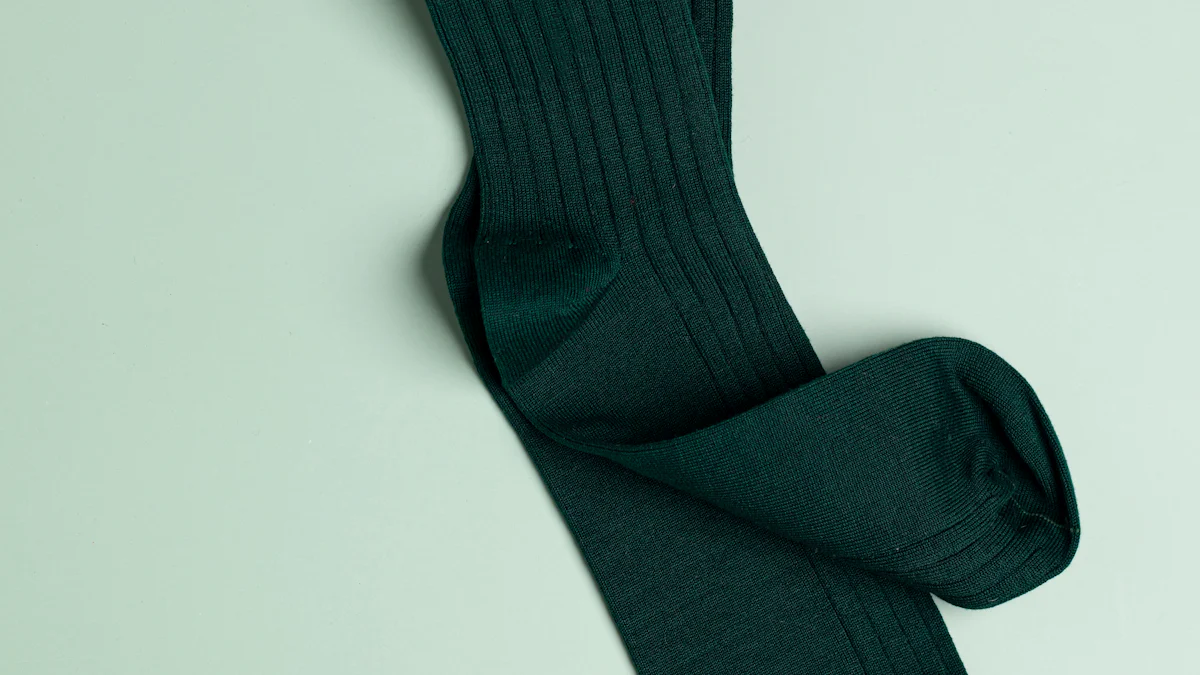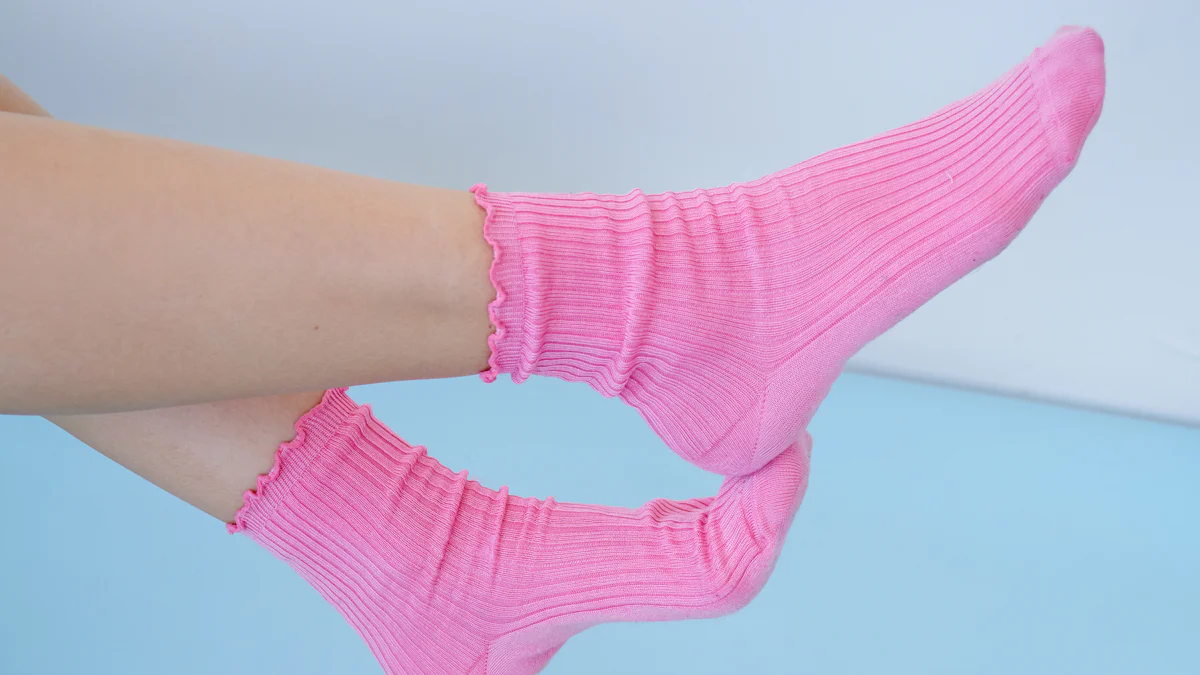
Material choice plays a crucial role in the comfort and durability of socks. Nylon in socks, a synthetic fiber, has become a popular material in sock manufacturing. DuPont introduced nylon at the New York World’s Fair, revolutionizing the textile industry. By 1941, nylon captured over 30% of the hosiery market. Today, manufacturers produce around 8 million pounds of nylon annually, accounting for about 12% of all synthetic fibers. Nylon’s versatility and strength make it a preferred choice in activewear, swimwear, and classic stockings.
What is Nylon?
Composition and Properties
Chemical Structure
Nylon, a synthetic polymer, originates from petrochemicals. Chemists create nylon through a process called polymerization, which involves combining monomers to form long chains. These chains give nylon its unique properties. The chemical structure of nylon consists of repeating units linked by amide bonds. This structure provides nylon with remarkable strength and flexibility.
Physical Characteristics
Nylon exhibits several notable physical characteristics. The material is lightweight yet exceptionally strong. Nylon’s elasticity allows it to stretch without breaking, making it ideal for various applications. Additionally, nylon in socks offers a smooth, silky texture, enhancing comfort. The material’s resilience ensures that it maintains its shape and integrity over time. Nylon also boasts excellent water resistance, which helps keep feet dry.
History of Nylon
Invention and Development
The invention of nylon marked a significant milestone in textile history. Wallace Carothers, a chemist at DuPont, developed nylon in the 1930s. The company introduced nylon to the public at the 1939 New York World’s Fair. This synthetic fiber quickly gained popularity due to its innovative properties. Nylon was the first fabric made entirely in a laboratory, setting a precedent for future synthetic materials.
Evolution in Textile Industry
Nylon’s introduction revolutionized the textile industry. Initially used in women’s stockings, nylon soon found applications in various products. Manufacturers recognized nylon’s potential for creating durable and versatile fabrics. Over the decades, nylon in socks became a staple due to its strength and comfort. Today, nylon remains a preferred choice for many types of clothing and accessories. The material’s ability to blend with other fibers allows for a wide range of designs and functionalities.
Benefits of Nylon in Socks

Durability
Resistance to Wear and Tear
Nylon in socks offers exceptional resistance to wear and tear. The synthetic polymer structure provides strength that withstands daily use. Activities like hiking and running demand durable materials. Nylon meets these requirements effectively. The abrasion-resistant nature ensures longevity, even under strenuous conditions.
Longevity Compared to Other Materials
Nylon in socks outlasts many other materials. Cotton and polyester often show signs of wear quickly. Nylon maintains its integrity over time. The material’s resilience makes it a preferred choice for long-lasting socks. Consumers benefit from fewer replacements and better value for money.
Comfort
Softness and Smooth Texture
Nylon in socks provides a soft and smooth texture. The synthetic fibers create a silky feel against the skin. This enhances overall comfort, making nylon socks ideal for everyday wear. The smooth texture reduces friction, preventing blisters and irritation.
Moisture-Wicking Properties
Nylon in socks excels at moisture-wicking. The material pulls sweat away from the skin. This promotes quicker evaporation, keeping feet dry. Athletes and active individuals appreciate this feature. Dry feet reduce the risk of fungal infections and discomfort.
Versatility
Blending with Other Materials
Manufacturers often blend nylon in socks with other fibers. This enhances the overall performance of the sock. Blends can include cotton, wool, or spandex. Each combination offers unique benefits. For example, nylon and spandex provide elasticity and support.
Variety of Designs and Colors
Nylon in socks allows for a wide range of designs and colors. The material accepts dyes well, resulting in vibrant hues. This versatility appeals to fashion-conscious consumers. Nylon socks come in various patterns and styles, catering to diverse preferences.
Potential Drawbacks of Nylon in Socks
Environmental Impact
Non-Biodegradable Nature
Nylon in socks poses significant environmental challenges. The synthetic nature of nylon means it does not biodegrade. This characteristic leads to long-lasting waste in landfills. Nylon remains in the environment indefinitely, contributing to plastic pollution. Washing nylon socks releases microfibers into water systems. These microfibers harm aquatic life and ecosystems.
Production Process Concerns
The production of nylon in socks involves resource-intensive processes. Manufacturing nylon emits nitrous oxide, a potent greenhouse gas. The chemical processes used in nylon production can lead to pollution. Efforts to recycle nylon aim to mitigate these impacts. However, recycling initiatives are not yet widespread. The environmental footprint of nylon remains a concern.
Sensitivity Issues
Skin Irritation for Some Individuals
Nylon in socks can cause skin irritation for some people. The synthetic fibers may not suit sensitive skin. Friction from nylon socks can lead to discomfort and rashes. Individuals with sensitive skin should consider alternative materials. Testing different sock materials can help identify the best option.
Allergic Reactions
Some individuals may experience allergic reactions to nylon in socks. The chemicals used in nylon production can trigger allergies. Symptoms may include itching, redness, and swelling. Those with known sensitivities should avoid nylon socks. Consulting a dermatologist can provide guidance on suitable materials.
Practical Examples and Recommendations

Popular Brands Using Nylon
Brand A
Darn Tough Socks stands out as a notable brand incorporating nylon in socks. This brand combines Merino Wool and nylon to achieve a patented fit and durability. The blend of these materials results in high tensile strength and resilience. Darn Tough Socks excel in all-season performance activities. The combination with Lycra Spandex further enhances the longevity and fit of the socks. The brand’s reputation for durable and comfortable socks makes it a preferred choice for many consumers.
Brand B
Smartwool also utilizes nylon in socks to enhance durability and comfort. The integration of nylon with Merino Wool creates a robust and flexible fabric. Smartwool socks offer excellent moisture-wicking properties, keeping feet dry during various activities. The brand focuses on producing high-performance socks suitable for outdoor adventures. The use of nylon ensures that Smartwool socks maintain their shape and integrity over time. Consumers appreciate the blend of natural and synthetic fibers for optimal performance.
How to Choose the Right Nylon Socks
Considerations for Different Activities
Selecting the right nylon socks depends on the intended activity. For hiking or running, prioritize socks with high durability and moisture-wicking properties. Look for blends that include nylon and spandex for added elasticity and support. For everyday wear, consider socks that offer a soft and smooth texture. Ensure the socks provide adequate comfort and prevent blisters. For fashion-conscious individuals, opt for nylon socks available in a variety of designs and colors.
Care and Maintenance Tips
Proper care and maintenance extend the lifespan of nylon socks. Follow these tips:
- Wash in Cold Water: Use cold water to prevent damage to the fibers.
- Avoid Bleach: Bleach can weaken the nylon, reducing its durability.
- Air Dry: Air drying helps maintain the shape and elasticity of the socks.
- Store Properly: Store socks in a cool, dry place to avoid moisture buildup.
Regularly inspect the socks for signs of wear and tear. Replace worn-out socks to ensure continued comfort and performance.
Nylon in socks offers several benefits and drawbacks. The material provides exceptional durability, elasticity, and moisture-wicking properties. Nylon’s resistance to wear and tear makes it ideal for long-lasting use. However, environmental concerns and potential skin sensitivities present challenges.
Choosing the right material for socks remains crucial. Material choice impacts comfort, performance, and sustainability. Consumers should consider their specific needs and preferences when selecting socks.
Nylon socks offer unique advantages worth considering. The combination of strength, comfort, and versatility makes nylon a valuable option for various activities.
See Also
Discovering the Range of Socks for Males and Females

